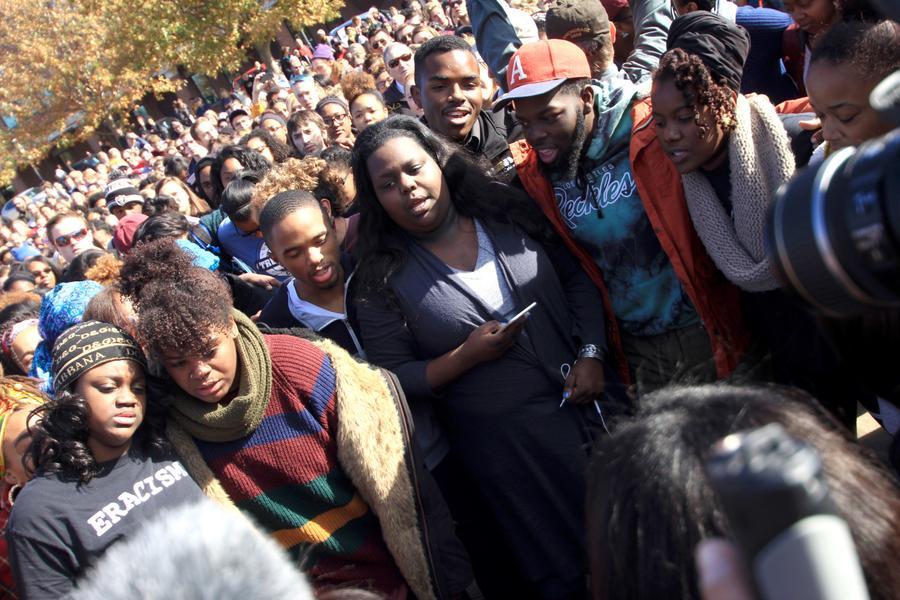
MU documentary journalism students Adam Dietrich and Varun Bajaj began building relationships with Concerned Student 1950 members on their campsite two days after Jonathan Butler announced his hunger strike. During those first few days, they didn’t even take their cameras out of their backpacks.
“It is a huge cliche that it’s more important to know when to put your camera down than when to pick it up,” Bajaj said. “Until we built those relationships, we didn’t push that boundary. But we were very up-front about explaining that we needed to film the most vulnerable moments for this story.”
The two eventually partnered with fellow journalism student Kellan Marvin, who worked as assistant editor, and became co-filmmakers of the documentary Concerned Student 1950. Through their unique access in the campsite, the film reveals the intimate moments of the original 11 students behind the closed doors of the Gaines/Oldham Black Culture Center, and shows the human moments of resiliency that came out of the movement. The midnight film premiere slipped into the True/False Film Festival lineup at the last minute. This free screening at the Missouri Theatre drew lines that wrapped halfway around the block. The showing even attracted attention from film director Spike Lee who came to the screening.
“The goal of the film was to reclaim the original purpose of the Concerned Student 1950 movement,” Dietrich said. “We didn’t want to just re-tell the media and Melissa Click controversies.”
All three filmmakers missed classes for two weeks and often filmed for 20 hours straight before rotating shifts. After the football players announced their strike in support of Butler, a frenzy of national media only made the job more difficult; still, they constantly prayed and ate with the members of Concerned Student 1950.
“The football team equated to money, so the big news stations all wanted to pick this story up,” Dietrich said. “We went from being a fish in a very small pond to a fish among sharks, and the pond was even smaller. But we had a responsibility to finish this.”
When the Yik-Yak threats started, Marvin filmed the vandalization of the Gaines/Oldham Black Culture Center sign at two a.m.
“I knew that my fear was 10 times worse for every black student on campus, and it’s never just at night,” Marvin said. “The most challenging thing for me was coping with that. Was perpetuating these images of student protestors going to continue some of the hatred that fuels the threats? By making this film, would we be putting people in more danger?”
French exchange student Tifani Akobe said she didn’t feel the difference between black and white before coming to MU. After watching the documentary, she threw her fist in the air.
“It wasn’t just showing the many stories the media spun off of the hunger strike,” Akobe said. “While I’ve been here, I’ve felt the pain of this movement. But I can go back to France and let people know the truth. Everyone should take examples from these students, and I admire them so much.”
A camper during the hunger strike, who would only identify her name as Concerned Student 1950, said she thought the film depicted the raw story of racial tension at MU.
“The filmmakers did such a beautiful job, and they were living this movement,” she said. “They came and reported with respect for this narrative.”
With the responsibility of filming came serious impacts on the filmmakers’ mental health.
“We were very emotionally vulnerable for two weeks, and my emotions were on my sleeve,” Bajaj said. “There wasn’t enough time to process, because we couldn’t stop working. And we didn’t want to insert ourselves into this narrative of the black students on campus, because it’s not about us at all.”
Dietrich wanted to start an uncomfortable, blunt and necessary conversation about race.
“We wanted to refocus the narrative of these protestors back to the point of why everything started in the first place,” Dietrich said. “Going back before the strikes, before the homecoming parade … there was a reason why these students began to protest. The goal of our film was to recreate that conversation.”
_Edited by Katie Rosso | [email protected]_